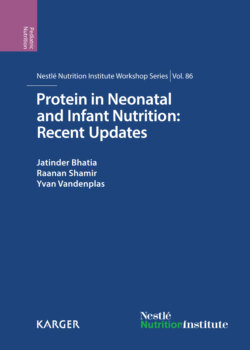Читать книгу Protein in Neonatal and Infant Nutrition: Recent Updates - Группа авторов - Страница 16
На сайте Литреса книга снята с продажи.
Infant Formula
ОглавлениеInfant formulas have been designed for infants who cannot be breastfed. Until the 20th century, there was no safe and reliable alternative to breastfeeding. With the increasing knowledge on the composition of milk (linked to the development of techniques for chemical analyses of milk), better assessment of the energy requirements of infants and advances in dairy technology, substitutes for breast milk were developed from the milk of other mammals. Successive improvements enabled the launch of the first whey-dominant formula in 1961 and the first Codex Alimentarius standard for infant formulas was issued in 1972. Today, besides breast milk, infant formula is the only other milk product which the medical community considers nutritionally acceptable for infants under the age of 1 year (as opposed to unmodified cow’s or goat’s milk).
Protein sources and processes have been modified along the years to optimize both the quality and the quantity of proteins in infant formulas in order to be closer to the composition but also the functional outcomes of breast milk.
Modern infant formulas provide similar amino acid profiles and protein contents as those found in breast milk. The most commonly used infant formulas contain purified cow’s milk whey and casein as a protein source. The composition of milk varies according to the mammal from which it comes, providing the correct rate of growth and development for the young of that species; thus for the human infant, human milk is obviously more suitable than cow’s milk. While cow’s milk and human milk contain a similar percentage of water, the relative amount of carbohydrates, proteins, fats, vitamins and minerals varies, because they are fine tuned to meet the nutritional requirements of that particular animal (table 2). As an example, the protein content in cow’s milk (5 g/100 kcal) is more than 3 times higher that of human milk (1.5 g/100 kcal). The ratio between caseins and whey proteins is also very different between cow’s milk and human milk: human milk contains 30% caseins/70% whey proteins, while in cow’s milk the ratio is 80:20, respectively (table 2). Given that the amount of total protein in cow’s milk is more than double that of human milk, cow’s milk clearly contains considerably more caseins than human milk. Although cow’s milk is the basis of almost all infant formulas, plain cow’s milk is not suited for infants because of its high casein content and low whey content, which may stress infant’s immature kidneys. Therefore, unmodified cow’s milk is not recommended before the age of 12 months.
Table 2. Composition of mature breast milk and cow’s milk (in g/kg of milk)
| Breast milk | Cow’s milk | |
| Lipids | 38 | 35 |
| Proteins (% whey/% caseins) | 15 (70/30) | 35 (20/80) |
| Carbohydrates | 70 | 48 |
| Minerals | ||
| K | 0.51 | 1.4 |
| Na | 0.15 | 0.5 |
| Ca | 0.30 | 1.2 |
| Mg | 0.04 | 0.12 |
| P | 0.14 | 0.95 |
| Cl | 0.41 | 1.1 |
Looking at these figures (the quantity and the quality of proteins in human milk and cow’s milk), it is virtually impossible to obtain an amino acid profile similar to human milk using unmodified cow’s milk protein fractions, and, in order to do so, it would be necessary to provide more protein to ensure enough of the limiting amino acids.
To circumvent this issue, cow’s milk used for infant formula undergoes processing. This includes steps to make proteins more easily digestible and to alter the whey/casein protein balance in order to be closer to that of human milk. Improvements in the quality of the proteins (an amino acid composition similar to that of breast milk) allowed manufacturers to reduce the quantity of proteins in infant formula to better mimic the growth pattern of formula-fed infants to that of the breastfed infants. Different manufacturing processes have been developed by infant formula companies such as using sweet whey to demineralize and fractionate the proteins of sweet whey by the removal of CaseinGlycoMacroPeptides (Nestlé-patented process). Using this optimized process and protein fractions made thereof, the amino acid profile and the protein content of the infant formula (1.8 g/100 kcal) moved a further step closer to that of breast milk. The use of this type of infant formula has indeed been shown to support similar weight gain, body mass index and head circumference as observed in breastfed infants [15, 16].
Clinical data showing that lower protein content in infant formula (i.e. 1.8 g/100 kcal) has a long-term preventive impact on body mass index and obesity risk have been published very recently [17, 18]. Infant formulas with even lower protein content (1.61-1.65 g/100 kcal) have been developed and clinically proven to be adequate from 3 to 6 months of age [19, 20].
In addition to providing amino acids as building blocks for growth, milk is the source of numerous bioactive factors, proteins such as hormones, cytokines or growth factors, which are involved in multiple physiological processes. Continuous efforts are invested to better understand their biological functions in suckling infants. New technologies could be used to produce bioactive substances present in low concentrations in human milk, but absent from bovine milk, with proven effect on nutrient utilization or other health benefits. Rigorous safety and efficacy evaluations should, however, be put in place before their implementation [21].
